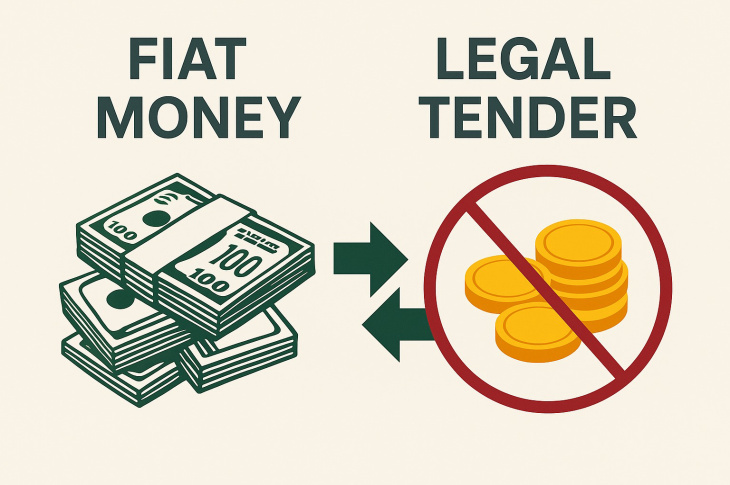Fiat Money vs. Legal Tender: Understanding the Key Differences
Introduction
In today’s modern economy, terms like “fiat money” and “legal tender” are frequently used when discussing currencies, central banks, and monetary systems. While both are foundational to financial transactions, many people mistakenly use these terms interchangeably.
However, fiat money and legal tender have distinct meanings, legal implications, and economic functions. Understanding these differences is essential not just for students and professionals but also for anyone who wants to make informed decisions regarding money and the economy.
What is Fiat Money?
Definition
Fiat money refers to currency that has no intrinsic value of its own. It is not backed by physical commodities like gold or silver. Instead, its value is derived entirely from the trust and confidence people have in the government or issuing authority.
Examples of fiat money: Indian Rupee (INR), US Dollar (USD), Euro (EUR), and Japanese Yen (JPY).
Characteristics of Fiat Money
-
No intrinsic value: It is just paper or digital numbers.
-
Not backed by commodities: Its value is not tied to gold or silver.
-
Government-issued: Central banks control its production.
-
Trust-based: Its value relies on the public’s faith in the government.
-
Easily printed: Governments can print more during economic crises.
-
Highly regulated: Controlled by monetary policy.
What is Legal Tender?
Definition
Legal tender is any form of money that a government officially recognises as acceptable for settling debts and transactions within its territory. By law, it must be accepted to discharge public or private debts.
Examples of legal tender: INR in India, GBP in the UK, USD in the USA.
Characteristics of Legal Tender
-
Government-mandated: Declared by law to be accepted for payment.
-
Can be fiat or commodity-backed: Most are fiat today, but historically included coins made of precious metals.
-
Standard denominations: Issued in fixed values (₹10, ₹50, ₹100, etc.).
-
Enforceable by law: Sellers and creditors must accept it.
-
Uniform system: Ensures consistent and legally recognised currency usage.
Key Differences Between Fiat Money and Legal Tender
| Feature | Fiat Money | Legal Tender |
|---|---|---|
| Definition | Currency with no intrinsic value, backed by government trust. | Currency that must be accepted by law for debt payments. |
| Value basis | Based on public trust and government credibility. | Based on legal enforceability for transactions. |
| Backing | Not backed by gold or silver. | May or may not be commodity-backed. |
| Mandatory use | Not necessarily; only if also legal tender. | Must be accepted in transactions. |
| Examples | INR, USD, Euro | INR, GBP, Yen (in their respective countries) |
| Issued by | Central banks | Central banks or treasury under law |
| Purpose | Tool for economic management. | Legal medium for debt settlement. |
| Risk of inflation | High, if mismanaged. | Can be high if fiat-based. |
| Legal protection | No legal compulsion to accept unless declared legal tender. | Legal requirement to accept. |
Similarities Between Fiat Money and Legal Tender
Despite their differences, both share several important similarities:
Government Issuance
Both are issued and regulated by a country’s government or central bank.
Used in Everyday Transactions
Both are accepted forms of payment for goods, services, and debt settlements within the country.
Part of the Modern Monetary System
Both play central roles in banking, commerce, inflation control, and economic policy.
Advantages and Disadvantages
Advantages of Fiat Money
-
Flexibility: Allows governments to manage the economy effectively.
-
Resource-saving: No need to mine gold or silver.
-
Supply control: Easier to increase or decrease supply as per need.
-
Economic stimulus: Can be used to boost spending during recession.
Disadvantages of Fiat Money
-
Inflation risk: Overprinting can devalue the currency.
-
Trust-dependent: Loses value if people stop believing in the government.
-
Subject to manipulation: Political misuse may destabilise the economy.
Advantages of Legal Tender
-
Legal protection: Ensures all creditors must accept it.
-
Uniformity: Promotes stable transactions across the economy.
-
Reduces disputes: Clear guidelines on what is acceptable for payment.
Disadvantages of Legal Tender
-
Restrictive: May limit alternative forms of payment (cryptocurrency, barter, etc.).
-
Inflation-prone: Most legal tender is fiat money today.
-
Over-reliance on state: Heavily dependent on government policy.
Legal Implications of Fiat Money and Legal Tender
Understanding the legal standing of fiat money and legal tender is vital for both consumers and businesses.
Legal Tender Laws
Legal tender laws ensure that certain forms of money must be accepted for debt repayment. For example, if someone tries to repay a debt with ₹500 notes, the creditor cannot legally refuse that payment in India.
Fiat Money Regulations
Fiat currencies are regulated by central banks (like the Reserve Bank of India or the Federal Reserve in the US). These institutions control:
-
Printing of currency
-
Interest rate decisions
-
Inflation targets
-
Money supply limits
Laws also govern how fiat money is handled in banking, trade, and international financial systems.
Summary Table: Fiat Money vs. Legal Tender
| Aspect | Fiat Money | Legal Tender |
|---|---|---|
| Definition | No intrinsic value, government-backed currency. | Officially mandated medium of payment by law. |
| Legal Requirement | Not necessarily legally accepted unless declared legal tender. | Must be accepted for settling debts. |
| Backing | Not backed by any commodity. | Can be commodity-backed or fiat. |
| Example | US Dollar, Indian Rupee (as fiat money). | INR is legal tender in India. |
| Value Origin | Trust in the issuing government. | Legal enforcement. |
| Legal Enforceability | May not be accepted unless also legal tender. | Mandated by law to be accepted. |
| Stability | Can fluctuate based on economic policies. | Stability comes from legal protection. |
| Role | Tool for economic policies. | Ensures smooth transaction and debt settlement. |
Conclusion
To sum it up, fiat money and legal tender are both essential to the modern financial ecosystem, but they are not the same.
-
Fiat money derives its value from public trust and government regulation, and is mainly used to control economic variables like inflation and interest rates.
-
Legal tender, on the other hand, gets its status from legal mandates, ensuring that it is universally accepted within a country for transactions and debt repayment.
In most cases today, legal tender is fiat money, but not all fiat money is automatically legal tender until it is declared so by law.
Understanding these differences can help individuals and businesses navigate financial decisions, manage risk, and understand how governments manage national economies.
Frequently asked questions
Is all fiat money legal tender?
Is all fiat money legal tender?
No. Fiat money becomes legal tender only when a government declares it acceptable for debt repayment under legal tender laws.
Can legal tender be something other than fiat money?
Can legal tender be something other than fiat money?
Yes. Historically, coins made of precious metals like gold and silver were legal tender. Today, most legal tender is fiat money.
Why is fiat money important?
Why is fiat money important?
It gives central banks flexibility to manage the economy by controlling the money supply, interest rates, and inflation.
What happens if public trust in fiat money is lost?
What happens if public trust in fiat money is lost?
The value of fiat money may drop significantly, leading to inflation or hyperinflation, as seen in historical cases like Zimbabwe or Venezuela.
Can cryptocurrencies be considered legal tender?
Can cryptocurrencies be considered legal tender?
No, cryptocurrencies are not legal tender in most countries. They can be used as a medium of exchange, but there is no legal obligation to accept them.
Who decides what is legal tender in a country?
Who decides what is legal tender in a country?
The central government, often in coordination with the central bank, determines and declares what constitutes legal tender under national law.
Trending
Frequently asked questions
Is all fiat money legal tender?
Is all fiat money legal tender?
No. Fiat money becomes legal tender only when a government declares it acceptable for debt repayment under legal tender laws.
Can legal tender be something other than fiat money?
Can legal tender be something other than fiat money?
Yes. Historically, coins made of precious metals like gold and silver were legal tender. Today, most legal tender is fiat money.
Why is fiat money important?
Why is fiat money important?
It gives central banks flexibility to manage the economy by controlling the money supply, interest rates, and inflation.
What happens if public trust in fiat money is lost?
What happens if public trust in fiat money is lost?
The value of fiat money may drop significantly, leading to inflation or hyperinflation, as seen in historical cases like Zimbabwe or Venezuela.
Can cryptocurrencies be considered legal tender?
Can cryptocurrencies be considered legal tender?
No, cryptocurrencies are not legal tender in most countries. They can be used as a medium of exchange, but there is no legal obligation to accept them.
Who decides what is legal tender in a country?
Who decides what is legal tender in a country?
The central government, often in coordination with the central bank, determines and declares what constitutes legal tender under national law.



Ask a Lawyer